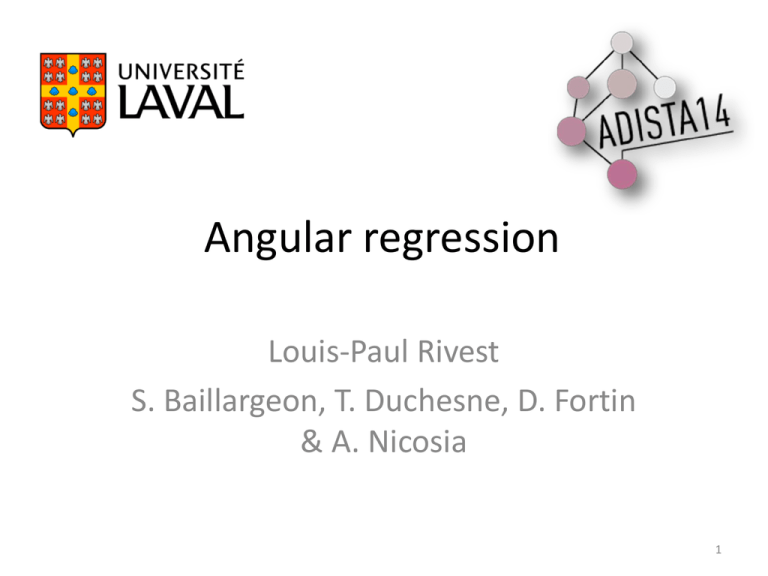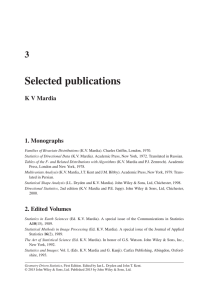Example - Advances in Directional Statistics
advertisement

Angular regression
Louis-Paul Rivest
S. Baillargeon, T. Duchesne, D. Fortin
& A. Nicosia
1
Summary
1- Animal movement in ecology
2- A general regression model for
circular variable
3- Modeling the errors
4- Data analysis and simulation
results
2
Animal movement in ecology
Study the interaction between an
animal and its environment using
1. GIS data on land cover
2. GPS data on animal motion
3. Special software (ArGIS) is used to
merge the data together
3
Animal movement in ecology
Target 1: meadow
Dependent variable: yt motion angle
at time t.
Predicted value: (y| x1t , …) a
compromise between several targets
x1t
Pt+1
yt
Target 2: Canopy gap
x2t
Pt
Pt-1
yt-1
4
Animal movement
Ecologists are uneasy about combining targets’ directions.
McClintock et al. (Ecological Monograph 2012) define a
compromise z,t between the angles t-1 and z,t as
Not right for a
non integer z
They are not fully satisfied with their definition. They add
a word of caution:
without providing details.
5
A general circular regression model
Let (x1, z1),..., (xp, zp) be explanatory variables
measured on each unit where x is an angle and z is
a positive linear variable.
The mean direction of y given (x1, z1),..., (xp, zp),
(y|x, z), is the direction of
cos( x j )
jzj
.
j 1
sin( x j )
p
6
Motivating example: latent classes
Mixture model: Each target is associated to a state. Given
state j the conditional model for yi is xji plus some errors
x1i 1i Pr p1
yi
x Pr p
pi
p
pi
p
p
j 1
j
1
The unconditional mean direction of yi is (y|x,z) with z=1
and jρj pj.
ρj =E{cos(ε j )} is the mean resultant length of the deviations εj in state j
7
A general circular regression model
p
p
p
( y | x, z ) arctan j z j sin( x j ), j z j cos( x j ) x j : z j
j 1
j 1
j 1
Standardization: 1 = z1 =1.
Examples (z=1):
• Mean direction model x1=0, and x2=/2
( y | x, z ) arctan 2 ,1 ( / 2, / 2).
• Rotation model x1=w, and x2=w+/2
( y | x, z ) w arctan 2 ,1.
8
A general circular regression model
p
p
( y | x, z ) arctan j z j sin( x j ), j z j cos( x j ) .
j 1
j 1
Examples (z=1):
• Decentred predictor (Rivest, 1997) x1=w,
and x2=w+/2, x3=0, and x3=/2
( y | x, z ) 2 arctan sin( w 1 2 ), r cos( w 1 2
32 42
with r
, 1 arctan( 2 ,1), 2 arctan( 4 , 3 )
2
1 2
9
A general circular regression model
p
p
( y | x, z ) arctan j z j sin( x j ), j z j cos( x j ) .
j 1
j 1
Presnell & all (1998) model: z1 = z2 =0, z3 = z4
=w, x1=0, x2=/2, x3=0, x4=/2,
( y | x, z ) arctan 2 4 w,1 3w
Jammalamadaka & Sen Gupta (2001) models.
The Moebius model of Downs & Mardia
(2002) does not belong!
10
Models for the errors
We use the von Mises density for both
specifications:
1
f ( )
exp cos( ) [- , ), 0
2 I 0 ( )
with population MRL
E{cos( )} A( )
I1 ( )
I 0 ( )
.
This is a modified
Bessel function
11
Modeling the errors
y ( y | x, z ) .
von Mises variable
Option 1 (homogeneity model):
The density of does not depend on neither
x nor z. It is von Mises with concentration
parameter .
12
Modeling the errors
y ( y | x, z ) .
von Mises variable
Option 2 (Consensus, Presnell et al, 1998):
The concentration parameter of is ℓ, where
ℓ is the length of p
cos( x j )
z
j 1
j
j
sin( x ) .
j
It is large when all the angles xj point in the
same direction.
13
Modeling the errors
y ( y | x, z ) .
The consensus model uses the parameters to
model the mean direction and the concentration of
the dependent angle y.
Wouldn’t it be better to use two independent sets of
parameters, one for the direction and one for the
error concentration, (Fisher, 1992 mixed models)?
14
Models for the errors
For the consensus model, the density of y given
(x,z) is
1
fc ( y)
exp cos[ y ( y | x, z )]
2 I 0 ( )
p
1
=
exp j z j cos( y x j ) .
2 I 0 ( )
j 1
This is the conditional distribution for a multivariate von
Mises model (Mardia, 1975). This density belongs to the
exponential family and parameter estimation should be
easy.
15
Parameter estimation
Strategy:
1. Maximize the von Mises Likelihood (use several starting values
for the homogeneous errors)
2. Use the inverse of the Fisher information matrix to approximate
the sampling distributions of the estimates (model based)
3. Calculate robust sandwich variance covariance matrices for the
parameter estimates (valid even if the model assumptions are
violated)
Alternative estimation strategies: use the projected normal (Presnell
& al., 1998) or the wrapped Cauchy as an error density.
16
Parameter estimation
Score functions [i= (y|xi, zi)] :
1-Homegenous errors
zi 2 sin( xi 2 i )
sin( yi ( y | xi , zi ))
cos( yi i )
i
z sin( x )
ip
i
ip
p
cos( xij )
2-Consensur errors (j=j, ℓi =ℓi)
length of j zij
j 1
sin( xij )
zi1 cos( yi xi1 ) zi1 cos( i xi1 ) A(
z
cos(
y
x
)
log
I
(
)
j ij
i
ij
0
i
z cos( y x ) z cos( x ) A(
i
ip
ip
i
ip
ip
)
i )
i
17
Parameter estimation
Data: (yi , xi , zi ), i=1,...,n
Maximizing the von Mises likelihood
with homogeneous errors leads to a
max-cosine estimation criterion for
the parameters {j}:
1
cos( yi ( y | xi , zi )) max
n
Numerical problems may occur.
Example: data simulated from the
homogeneous error model:
n=50, p=2, 2 =0.5
x1 =0, x2 U(-,), =0.4
18
Parameter estimation
Properties:
1. The max-cosine estimator for is consistent under
the two error specifications, homogeneous and
consensus;
2. When the errors are homogeneous, the consensus
MLE might not be consistent. A lack of robustness to
the specifications of the errors’ distribution is the
price to pay for the numerical stability of the
likelihood.
19
Parameter estimation
Properties:
1. Bias: In a one parameter model with
homogenoeus errors, the consensus MLE
underestimates 2 (by up to 20%)
2. MLE: The algorithm that maximizes the
homogeneous likelihood must use several starting
values (more that 1000!)
20
A time series model
The conditional mean direction of yt is a compromise
between yt-1 and x0 :
( yt | x0 , yt 1 ) arctan sin( yt 1 ) 2 sin( x0 ),cos( yt 1 ) 2 cos( x0 ).
Under consensus errors with von Mises distributions
t
yt
Marginal cosine distribution (Mardia et al, 2007)
Stationary distribution unknown for homogeneous
errors.
21
A time series model
This is a “Biased Correlated Random Walk” in Ecology:
yt= direction of animal movement at time t
x0=x0t= direction of a target to which an animal might be
attracted (“Directional Bias”)
The estimation of 2 relies on the methods presented
earlier.
22
Example 1: Periwinkle data
y = direction of displacement
x = distance traveled
Presnell et al. (1998): projected normal errors
Presnell et al fit
Consensus fit
ˆ ( y | x )
ˆ ( y | x)
arctan .13 .040 x,1 0.024 x
arctan 0.062 .060 x,1 0.026 x
Homogeneous fit: Numerical problems
23
Example 1: Periwinkle data
24
Example 2: Dancose (2011) digitized
bison track data
yi = track orientation for pixel i
x1i = track orientation for pixel i-1
x2i = angle for next meadow
z2i = log(distance to next meadow)
x3i = angle for next canopy gap
z3i = log(distance to next canopy gap)
K=218 trails for 5600 pixels
Model considered
ˆ ( y | x, z) xi1 xi 2 xi 3 xi 2 : zi 2 xi 3 : zi 3
25
Bison track data: homegenous model
Model
ˆ ( y | x, z) xi1 xi 2 xi 3 xi 2 : zi 2 xi 3 : zi 3
estim.
beta2 1.06
beta3 0.07
beta4 -0.16
beta5 -0.002
s.e.(R)
0.10
0.03
0.018
0.006
s.e.(FI)
0.05
0.03
0.009
0.006
S
S
S
NS
The tracks are “biased” towards target meadows (TM) and
canopy gaps.
When approaching a meadow, the bisons zoom in.
The weight of the TM angle is 1-0.16 log(D)/1.06D-0.15
26 .
Bison track data: consensus model
Model
ˆ ( y | x, z) xi1 xi 2 xi 3 xi 2 : zi 2 xi 3 : zi 3
estim Homo
beta2 1.06
beta3 0.07
beta4 -0.16
beta5 -0.002
estim Consen
1.24
0.07
-0.19
-0.003
se(FI)
0.05
0.03
0.009
0.006
The two sets of estimates are similar and lead to the same
conclusion.
27
Discussion
Multivariate angular regression applies beyond
animal movement:
• Meteo: ensemble prediction of wind direction
• Experimental psychology: real and perceived
orientation of features
• Geophysics: direction of earthquake ground
movement and direction of steepest descent
Thank you!
28
References
Dancose, K., D. Fortin, and X. L. Guo. 2011. Mechanisms of functional
connectivity: the case of free-ranging bison in a forest landscape. Ecological
Applications 21:1871-1885.
Downs, T. D. and Mardia, K. V. (2002) Circular regression. Biometrika,89,683-697
Fisher, N.I., Lee A.J. (1992). Regression models for angular responses. Biometrics,
48, 665-677
Fortin & al (2005) Wolves influence elk movements: behavior shapes a trophic
cascade in Yellowstone National Park, Ecology, 86(5), 2005, pp. 1320–1330
Jammalamadaka, S. R. and SenGupta, A. (2001) Topics in Circular Statistics.
World Scientific: Singapour
Mardia, K.V. and Jupp, P.E. (1999) Directional Statistics,John Wiley, New York
Presnell, B., Morrison, S.P., and Littell, R.C. (1998). Projected multivariate linear
models for directional data. JASA. 93(443): 1068-1077
Rivest, L.-P. (1997). A decentred predictor for circular-circular regression.
29
Biometrika, 84, 717-726.








